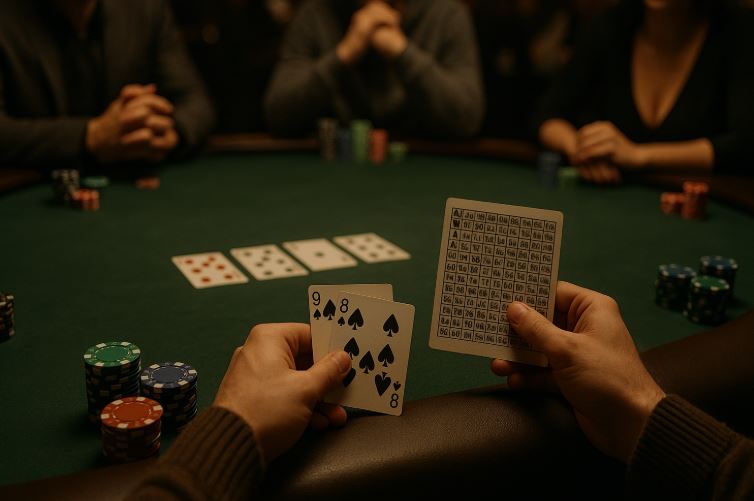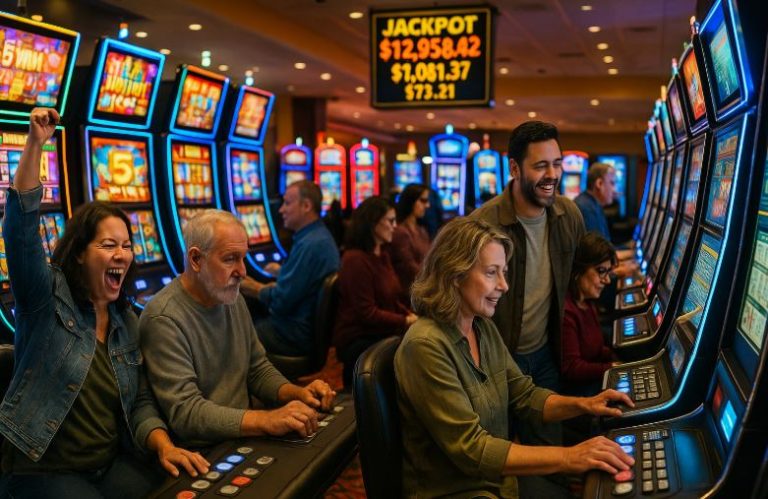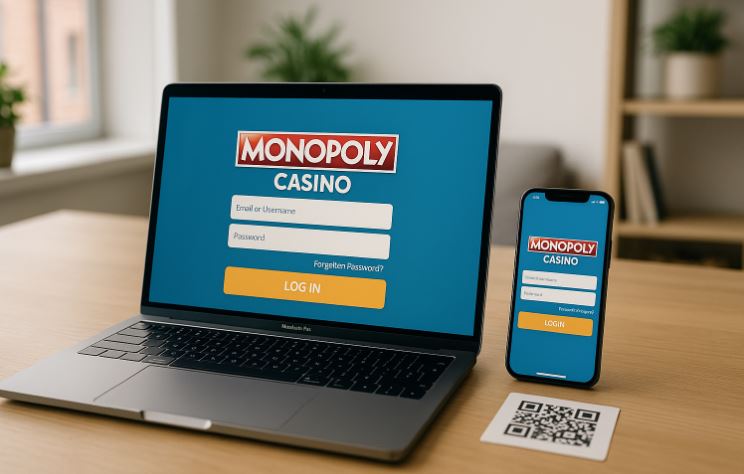Poker Cheat Sheet | Learn Odds, Outs, and Positioning Fast
Everyone remembers their first poker game. Maybe it was at a smoky home game with friends or an online tournament that had you glued to the screen for hours. There’s excitement, nerves, and that constant voice in your head asking, “Am I doing this right?”
Whether you are a complete beginner or someone trying to sharpen their poker skills, a poker cheat sheet can be your best friend at the table.
A poker cheat sheet is not a way to cheat opponents. Instead, it is a quick reference tool that summarises key strategies, odds, hand rankings, and tips to help you make better decisions. Think of it as your poker roadmap, helping you navigate complex situations with confidence and avoid common mistakes.
In this blog, we will break down everything you need to know: from poker odds and outs to positioning, hand selection, tournament strategies, and bankroll tips.
Whether you play Texas Hold’em, Five-Card Draw, or online cash games, this guide will help you level up your poker skills and play smarter. Let’s dive in.
What Is a Poker Cheat Sheet?

A poker cheat sheet is a set of helpful tips and reminders that players can reference during poker games. It includes essential strategies, hand rankings, odds, and common poker terms. It is not meant to replace skill or practice but to assist players, especially beginners, by providing a quick guide when facing tricky decisions.
A well-designed poker cheat sheet can:
- Help you remember hand rankings
- Guide you on when to bet, call, raise, or fold
- Provide odds and outs at a glance
- Explain positions and their importance
- Offer tips on avoiding tilt and improving emotional control
Many players use digital cheat sheets or printouts, and they’re especially popular among online poker players who want an easy reference nearby. While most formal tournaments and casinos don’t allow cheat sheets at the table, they are excellent tools for practice games and online play.
Types of Poker Cheat Sheets
Poker cheat sheets come in several forms, depending on the game type and what you want to focus on. Here are the most common ones:
Five-Card Poker Cheat Sheet
This focuses on the classic Five-Card Draw game. It includes advice on which hands to hold or discard, basic bluffing tips, and the probabilities of improving your hand.
Texas Hold’em Cheat Sheet
Texas Hold’em is the most popular poker variant worldwide. This cheat sheet covers everything from starting hand recommendations to preflop and postflop strategy, pot odds, and betting patterns.
Poker Guide Sheet
A poker guide sheet provides a broader overview, covering multiple game types and their rules, common terminology, betting structures, and etiquette.
Poker Hand Cheat Sheet
This is a concise list of hand rankings, from Royal Flush down to High Card. It’s perfect for beginners who need help quickly identifying winning hands.
Poker Odds Cheat Sheet
This sheet provides odds for common situations, like hitting a flush or straight, drawing pairs, or improving after the flop. It helps you calculate whether a call or bet is worth the risk.
Poker Lingo Cheat Sheet
Understanding poker slang is crucial at the table. A lingo cheat sheet includes terms like blinds, button, check, raise, fold, tilt, nuts, and showdown, helping you stay in the loop during conversations and play.
How Do Poker Hand Rankings Work?

Understanding hand rankings is the foundation of good poker play. Here’s a breakdown, from strongest to weakest:
| Hand | Description |
| Royal Flush | A, K, Q, J, 10, all of the same suit |
| Straight Flush | Any five consecutive cards, same suit (e.g., 9-8-7-6-5 of hearts) |
| Four of a Kind | Four cards of the same rank (e.g., four Kings) |
| Full House | Three of one rank, two of another (e.g., three Aces, two Kings) |
| Flush | Five cards, same suit, not in sequence (e.g., 10-8-6-4-2 of spades) |
| Straight | Five consecutive cards, mixed suits (e.g., 7-6-5-4-3) |
| Three of a Kind | Three cards of the same rank (e.g., three Queens) |
| Two Pair | Two sets of two cards (e.g., two Jacks, two 7s) |
| One Pair | Two cards of the same rank (e.g., two 9s) |
| High Card | Highest card when no other hand is made (e.g., Ace high) |
Knowing this hierarchy will help you decide when to bet aggressively, when to fold, and when to bluff confidently.
How Does Positioning at the Poker Table Affect Strategy?
Table position is one of the most underrated aspects of poker. Where you sit relative to the dealer determines when you act in each betting round, and that influences your strategy.
Common Poker Table Positions
| Position | Description |
| Small Blind (SB) | Left of the dealer; posts a small forced bet before cards are dealt |
| Big Blind (BB) | Left of the small blind; posts a larger forced bet |
| Under-the-Gun (UTG) | First to act preflop; most vulnerable, should play tight |
| Hijack (HJ) | Two seats right of the dealer; opportunities for steals and aggressive play |
| Cutoff (CO) | One seat right of the dealer; strong position for betting |
| Button (BTN) | Dealer position; acts last postflop, most advantageous position |
Why Position Matters?
Players in later positions have more information about other players’ actions, allowing them to make better decisions. Early positions require tight, conservative play, while late positions allow for more flexibility and bluffing. Understanding how position impacts each phase of the hand can transform your win rate.
What Are Poker Odds and Outs?

Poker is a game of skill, strategy, and numbers. Understanding odds and outs is what separates casual players from consistent winners.
What Are Outs?
Outs are the unseen cards that will improve your hand to a likely winner. For example, if you have four cards to a flush, nine cards remain in the deck to complete it. These nine cards are your outs.
What Are Odds?
Odds tell you the probability of hitting one of your outs on the next card or by the river. Knowing the odds helps you decide whether calling, betting, or folding is mathematically sound.
Essential Poker Odds (Approximate)
| Poker Hand Situation | Probability |
| Royal Flush | Extremely rare |
| Full House or Better | 3.3% |
| Flush | 0.8% |
| Straight | 0.6% |
| Two Pair or Better | 23% |
| Pair on the Flop | 32% |
| Flush Draw by the River | 19.6% |
| Flopping a Set | 11.8% |
| Flush Draw on the Flop | 10.9% |
| Open-Ended Straight Draw | 31.5% |
| Straight Draw on the Flop | 8.4% |
Understanding these numbers helps you know when a call is worth it or when to fold and save chips.
Pot Odds and Implied Odds
Pot odds compare the current size of the pot to the cost of your next call. Implied odds consider future winnings if you hit your hand. Both help make better betting decisions, especially when facing large bets or considering a draw.
What Common Poker Terms Should Beginners Know?
For newcomers, poker can feel like learning a new language. Here’s a small poker lingo cheat sheet to help you navigate conversations and strategy.
- Blinds: Forced bets to start the action.
- Button: The dealer position, the last to act postflop.
- Check: Passing the action without betting.
- Raise: Increasing the size of the current bet.
- Fold: Giving up your hand and any claim to the pot.
- Call: Matching the current bet to stay in.
- All-In: Betting all your chips.
- Pot: The total amount of money or chips wagered in a hand.
- Showdown: The reveal of hands after the final betting round.
- Flopping: Seeing the first three community cards.
- Turn: The fourth community card.
- River: The fifth and final community card.
- Nuts: The best possible hand at a given time.
- Tilt: Playing emotionally, often after a bad beat.
- Fish: An inexperienced player.
- Shark: A highly skilled player.
- Railbird: A spectator watching the action.
Learning these terms can improve your table presence and understanding.
How Should You Play Texas Hold’em Preflop and Postflop?

Texas Hold’em is the most popular poker variant and demands different strategies before and after the flop.
Preflop Strategy
Your goal preflop is to enter the pot with the strongest possible hands, especially from early positions. The best players stick to a solid, disciplined range and adjust it based on position.
Recommended hands from each position:
- Early Position: AA, KK, QQ, JJ, TT, AK, AQ
- Middle Position: Add AJ, KQ, KJ, QJ
- Cutoff/Button: Add AT, suited connectors (JTs, T9s), small pairs
- Small Blind: Strong pairs and suited hands
- Big Blind: Adjust based on whether it’s limped or raised to you
How Much Should You Raise?
In most games, 2.5x–3x the big blind is standard. If there are limpers before you, raise bigger to isolate. For example, if the big blind is $1, raise to $3. With one limper, raise to $4.
Postflop Strategy
Postflop play is where many players struggle. You want to continue betting (called a continuation bet or C-bet) when you have the initiative preflop, especially heads-up.
When to Bet Postflop?
- You hit top pair or better.
- You have a strong draw (like a flush or open-ended straight draw).
- You are bluffing in a favourable spot (against tight opponents on scary boards).
When to Check or Call?
- You have a marginal hand.
- You’re controlling the pot size.
- You want to let aggressive opponents bluff.
When to Fold?
- You have no connection to the board.
- You face heavy action with a weak holding.
Being able to categorise hands quickly into strong, medium, draws, or trash is key.
Can a Poker Cheat Sheet Help in Tournaments?
Yes, and the impact can be massive. Tournaments bring changing dynamics, and cheat sheets can remind you how to adjust.
Early Stage Tips
- Play tight, strong hands.
- Avoid big coin flips early.
- Focus on observing players.
Middle Stage
- Start widening your range slightly.
- Look for spots to steal blinds, especially from late position.
- Pay attention to stack sizes.
Bubble Play
This is the period just before players reach the money. Many tighten up, so:
- Be aggressive in late position.
- Pressure medium stacks.
- Avoid tangling with big stacks unless you have premium hands.
Final Table
At the final table, stack sizes and payout jumps matter.
- Short stacks: Look for good all-in spots.
- Medium stacks: Be cautious but attack the right targets.
- Big stacks: Apply pressure on smaller stacks.
Remember, playing to win is the mindset that takes you from finalist to champion.
Are Poker Cheat Sheets Legal in Casinos and Online?

One of the most common questions beginners ask is whether they are allowed to use a poker cheat sheet at a casino table or online.
Using Cheat Sheets in Casinos
In most formal casinos and tournaments, players are not allowed to use physical or digital cheat sheets at the table.
Casinos consider them a potential unfair advantage, even if the sheet contains only public information like hand rankings or odds. Before bringing a cheat sheet, always check with the casino staff to avoid misunderstandings or penalties.
Using Cheat Sheets Online
For online games, especially at home with friends, cheat sheets are commonly used as learning tools.
Many online poker sites do not allow software that gives players real-time advice, but having a printed or separate guide for reference is generally fine if it does not directly interact with the game client.
When Are Cheat Sheets Useful?
- Practice games at home
- Online self-study sessions
- Reviewing hands after a session
They are best seen as study aids, not crutches. Once you’ve internalised the information, you’ll no longer need to glance at a guide during live games.
How to Avoid Tilt and Keep Emotional Control
One of the biggest threats to a poker player’s success is not bad cards but bad reactions. Tilt refers to the emotional frustration or agitation that leads players to make irrational decisions.
What Causes Tilt?
- Bad beats (losing despite having the stronger hand)
- Long losing streaks
- Opponents’ trash talk
- Fatigue or distraction
How to Prevent Tilt?
- Take breaks: Step away from the table when you feel frustration building.
- Focus on decisions, not results: Good decisions can still lead to bad outcomes.
- Set stop-loss limits: Know when to walk away for the day.
- Practice mindfulness: Breathe deeply, reset your focus.
- Review sessions later: Avoid analysing hands emotionally right after they happen.
Even professional players struggle with tilt. What separates the pros is their ability to manage it and maintain discipline over the long run.
Best Tips to Improve Your Poker Game

Improving at poker takes time, study, and practice. Here are some tried-and-tested tips:
For Cash Games
- Play tight from early positions; widen up near the button.
- Avoid limping; raise or fold.
- Target weaker players and avoid tough regulars.
- Pay attention to player habits and take notes.
For Tournaments
- Play cautiously early, avoiding unnecessary risks.
- Exploit the bubble with aggression.
- Be aware of ICM (Independent Chip Model) at the final table.
- Play to win, not just to make the money.
For Heads-Up Play
- Be aggressive with position.
- Mix up your play to stay unpredictable.
- Don’t be scared to re-raise light.
- Identify and exploit your opponent’s patterns.
For Bankroll Management
- Track every session’s profit and loss.
- Maintain at least 30 buy-ins for cash games.
- Treat your bankroll as an investment, not disposable cash.
- Take advantage of bonuses or rakeback offers.
For Learning
- Watch training videos and read strategy articles.
- Use hand tracking software if allowed online.
- Join forums or study groups.
- Review your sessions and learn from mistakes.
Poker success is a mix of strategy, discipline, and self-awareness. Combining a poker cheat sheet with regular study can speed up your progress significantly.
Conclusion
A poker cheat sheet is more than just a list of rules, it’s a roadmap for growth. Whether you’re playing at home with friends, grinding low-stakes cash games, or diving into online tournaments, having a cheat sheet nearby can sharpen your decisions, help you manage your bankroll, and teach you to play each hand and position with confidence.
We’ve covered everything from hand rankings and odds to positions, tournament strategies, common terms, tilt control, and improvement tips.
The most important takeaway is this: poker is a journey. Cheat sheets help you get started, but over time, your experience, study, and emotional discipline will be what truly shapes you into a winning player.
Keep learning, stay disciplined, and most importantly, enjoy the game. Poker is not just about money, it’s about strategy, patience, and the thrill of outplaying your opponents.
FAQs
What is the main purpose of a poker cheat sheet?
A poker cheat sheet helps players remember important strategies, hand rankings, odds, and positional advice, making it easier to play smarter decisions.
Can using a poker cheat sheet improve my game?
Yes, especially for beginners and intermediate players, cheat sheets can speed up learning, improve decision-making, and reduce common mistakes.
Are poker cheat sheets allowed at casinos?
In most casinos and tournaments, physical or digital cheat sheets are not allowed at the table, but they are fine as study tools away from the game.
What is the best poker variant to use a cheat sheet for?
Cheat sheets are most commonly used for Texas Hold’em, but they can also be helpful in Five-Card Draw, Omaha, and other variants.
How do I handle bad beats in poker?
Focus on making good decisions, not just results. Take breaks, manage tilt, and remember that variance is a natural part of poker.
Should I adjust my strategy in online games?
Yes, online games often play differently. Players are more aggressive, so tightening up your range and focusing on fundamentals can help.
How many buy-ins should I have for cash games?
It’s recommended to have at least 30 buy-ins for the stakes you are playing, to handle variance safely and avoid going broke.
Disclaimer:
This information is shared for educational purposes only. We do not endorse gambling. Please make informed choices and gamble responsibly if you choose to participate.
Read Next:







